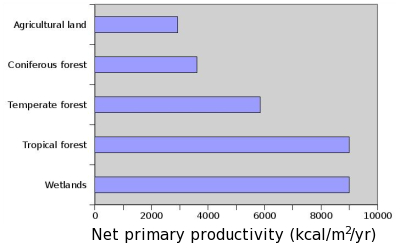
Wetland garden
 Jacke
used the numbers shown here as one of his arguments for forest
gardening. He
noted that forests are much more productive environments than annual
agricultural land in terms of the amount of solar energy converted to
biomass after the needs of the plants in the ecosystem are met.
Jacke
used the numbers shown here as one of his arguments for forest
gardening. He
noted that forests are much more productive environments than annual
agricultural land in terms of the amount of solar energy converted to
biomass after the needs of the plants in the ecosystem are met.
His point is well taken,
but I was more intrigued by another part of the graph. Notice how
wetlands are just as productive as tropical forests --- nearly double
the productivity of temperate forests? Can we create swamp
gardens that mimic wetlands just like forest gardens mimic forests?
Some folks already make
use of wetlands, but they seem to focus on the potential
of wetlands to break down contaminants in graywater or sewage. Since we have lots of
floodplain land on our property, I can't help wonder if we could do
something more interesting with it. Maybe find a way to harvest
biomass for mulch and compost to feed my hungry vegetable garden?
Rotate animals through it at a low enough rate that they take advantage
of the fertility without causing erosion? I'd be curious to hear
if anyone has better ideas!
Want more in-depth information? Browse through our books.
Or explore more posts by date or by subject.
About us: Anna Hess and Mark Hamilton spent over a decade living self-sufficiently in the mountains of Virginia before moving north to start over from scratch in the foothills of Ohio. They've experimented with permaculture, no-till gardening, trailersteading, home-based microbusinesses and much more, writing about their adventures in both blogs and books.
Want to be notified when new comments are posted on this page? Click on the RSS button after you add a comment to subscribe to the comment feed, or simply check the box beside "email replies to me" while writing your comment.

One can actually combine the waste-water processing with bio-mass production. I am interested in willow crops for compost material to create hot water and natural gas via the Jean Pain method.
However, I imagine that the wetlands production level referenced in the graph is specific to climates, unlike here in Alberta, where the wetlands can produce year round.
Willows are a very good idea (especially since I already have some growing wild down there. I'll have to look into the Jean Pain method.
I'll have to look into the Jean Pain method.
I also enjoyed following the link to your blog. Thanks for commenting so that I could find you!
Check out the Taranaki Farms link at my blog. They have a video which outlines the Jean Pain method, and talks some about Jean Pain himself. Both it and the Taranaki site itself are excellent, I think.
I`m glad to meet you both as well.
Here you go:
http://www.youtube.com/watch?v=JHRvwNJRNag&feature=player_embedded
http://www.youtube.com/watch?v=zGCj7NA0OIs&feature=related
Unfortunately, to really work it has to be done on a similar size scale as they are using, or larger I guess...so its quite a job.